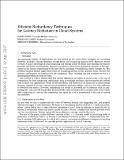Efficient Redundancy Techniques for Latency Reduction in Cloud Systems
Author(s)
Joshi, Gauri; Soljanin, Emina; Wornell, Gregory W
DownloadAccepted version (1.172Mb)
Terms of use
Metadata
Show full item recordAbstract
© 2017 ACM. In cloud computing systems, assigning a task to multiple servers and waiting for the earliest copy to finish is an effective method to combat the variability in response time of individual servers and reduce latency. But adding redundancy may result in higher cost of computing resources, as well as an increase in queueing delay due to higher traffic load. This work helps in understanding when and how redundancy gives a cost-efficient reduction in latency. For a general task service time distribution, we compare different redundancy strategies in terms of the number of redundant tasks and the time when they are issued and canceled. We get the insight that the log-concavity of the task service time creates a dichotomy of when adding redundancy helps. If the service time distribution is log-convex (i.e., log of the tail probability is convex), then adding maximum redundancy reduces both latency and cost. And if it is log-concave (i.e., log of the tail probability is concave), then less redundancy, and early cancellation of redundant tasks is more effective. Using these insights, we design a general redundancy strategy that achieves a good latency-cost trade-off for an arbitrary service time distribution. This work also generalizes and extends some results in the analysis of fork-join queues.
Date issued
2017Department
Massachusetts Institute of Technology. Department of Electrical Engineering and Computer ScienceJournal
ACM Transactions on Modeling and Performance Evaluation of Computing Systems
Publisher
Association for Computing Machinery (ACM)